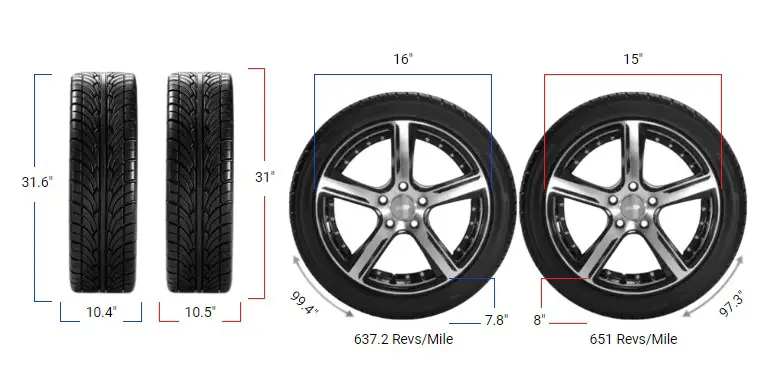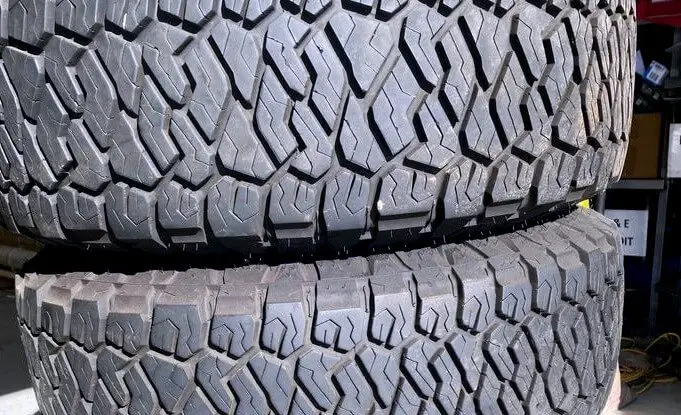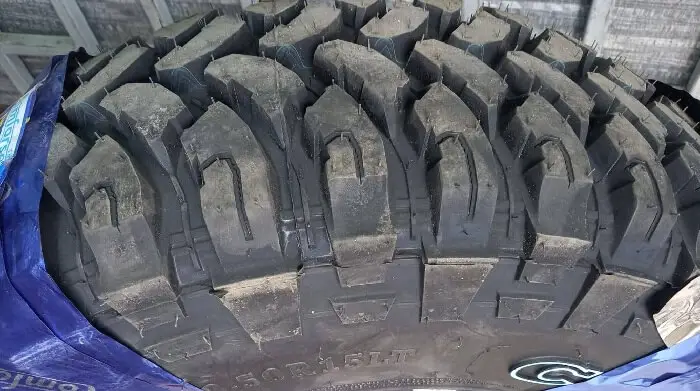Tire Size 265/75r16 vs 31×10.5r15

Switching from 265/75r16 to 31×10.5r15 tires is generally feasible, as the size difference falls within the acceptable 3% range. This change results in a slightly smaller diameter and width, which can affect various aspects of your vehicle’s performance.
- Tire diameter decreases by 2.1%, within the acceptable 3% range
- Minimal width increase of 0.8%
- Slight reduction in ground clearance
- Minor impact on fuel efficiency and speedometer readings
- Potential for improved off-road performance
265/75r16 vs 31×10.5r15
The primary distinction between 265/75r16 and 31×10.5r15 tires lies in their overall diameter. This change, while within the acceptable range, can subtly influence various aspects of vehicle performance and aesthetics.

Fitment Guide
It’s crucial to stay within the 3% diameter range to ensure proper fitment and performance. In this case, the 2.1% decrease falls within the acceptable range, making the switch from 265/75r16 to 31×10.5r15 generally safe and feasible.
However, it’s always wise to consult with a tire professional or your vehicle manufacturer to confirm compatibility with your specific make and model.
On-Road Impact
Switching to 31×10.5r15 tires can have subtle effects on your vehicle’s on-road performance. These changes may be noticeable in certain situations but are generally minimal for everyday driving.

- Ground Clearance: The smaller diameter of the 31×10.5r15 tires results in a slight reduction in ground clearance. While the 0.67-inch (17.06 mm) difference may seem negligible, it could be noticeable when navigating speed bumps or steep driveways. However, for most on-road situations, this change is unlikely to cause significant issues.
- Gas Mileage: The smaller diameter of the new tires means they will rotate more frequently to cover the same distance. This increase in revolutions per mile (13.82 more) may lead to a slight decrease in fuel efficiency. However, the impact is minimal, and most drivers are unlikely to notice a significant change in their gas mileage.
- Aesthetics: The 31×10.5r15 tires are slightly narrower and have a marginally smaller overall diameter. This change might give your vehicle a slightly different look, potentially appearing less aggressive or rugged. However, the visual difference is subtle and may not be immediately noticeable to most observers.
- Ride Comfort: The new tires have a slightly taller sidewall (0.16 inches or 4.17 mm), which could potentially provide a marginally softer ride. However, this difference is so small that most drivers are unlikely to notice any significant change in ride comfort.
- Speedometer Accuracy: The smaller diameter of the 31×10.5r15 tires will cause your speedometer to read slightly higher than your actual speed. For example, when your speedometer shows 20 mph, you’ll actually be traveling at 19.58 mph. While this 2.1% difference is small, it’s worth being aware of, especially when driving near speed limits or in speed-monitored areas.
Off-Road Impact
The switch to 31×10.5r15 tires can have some effects on your vehicle’s off-road capabilities, though these changes are generally minor.

- Traction: The slightly wider profile of the 31×10.5r15 tires (0.08 inches or 2 mm wider) may provide a marginal increase in off-road traction. This could be beneficial when navigating loose or muddy terrain, although the difference is likely to be minimal.
- Obstacle Clearance: The smaller diameter of the new tires results in a slight decrease in overall vehicle height. This may marginally reduce your ability to clear large obstacles or navigate deep ruts. However, the 0.67-inch (17.06 mm) difference is unlikely to significantly impact most off-road situations.
- Wheel Well Fitment: The slightly smaller diameter and width of the 31×10.5r15 tires may provide a bit more clearance in the wheel wells. This could be beneficial when the suspension is fully compressed or when sharp turning angles are required on challenging trails.
- Acceleration: The smaller diameter tires will slightly reduce your vehicle’s effective gear ratio. This may result in a small increase in acceleration, which could be helpful in certain off-road situations where quick bursts of speed are needed.
Durability & Wear
The difference in tire size is unlikely to have a significant impact on durability or wear patterns.
However, the slightly increased revolutions per mile (13.82 more) of the 31×10.5r15 tires means they’ll complete more rotations over the same distance.
This could potentially lead to slightly faster wear, but the difference is minimal and unlikely to significantly affect the overall lifespan of the tires.
31×10.50r15 Equivalent
The 31×10.50r15 tire size does not have an exact equivalent in the metric tire sizing system, but the closest match is 265/75r15.
Metric tire sizes are typically rounded to 5mm increments, so the 265/75r15 provides the nearest metric dimensions to 31×10.50r15. The section width of 265mm converts to 10.43 inches, close to the 10.5-inch width of 31×10.50r15.
While not precisely the same, the 265/75r15 metric tire size has similar measurements and is the closest equivalent to 31×10.50r15. Even though not an exact match, the 265/75r15 fits well as an equivalent replacement.
What is the Difference Between 265/75r16 and 31×10.5r15?
The main difference between 265/75r16 and 31×10.5r15 tires lies in their overall diameter. The 265/75r16 tire has a diameter of 31.65 inches (803.9 mm), while the 31×10.5r15 tire has a diameter of 30.98 inches (786.84 mm).
This results in a difference of 0.67 inches (17.06 mm), with the 265/75r16 being slightly larger. This 2.1% difference in diameter can affect various aspects of vehicle performance, including ground clearance, speedometer accuracy, and fuel efficiency, albeit to a minor degree.
Can I Use 265/75r16 Instead of 31×10.5r15?
Yes, you can use 265/75r16 tires instead of 31×10.5r15 tires. The difference in diameter between these two tire sizes is 2.1%, which falls within the generally accepted range of plus or minus 3%.
This means the switch should not cause significant issues with your vehicle’s performance or safety. However, it’s always advisable to consult with a tire professional or your vehicle manufacturer to ensure compatibility with your specific make and model.
How Much Taller Is A 265/75r16 Tire Than A 31×10.5r15?
A 265/75r16 tire is 0.67 inches (17.06 mm) taller than a 31×10.5r15 tire. The 265/75r16 has a diameter of 31.65 inches (803.9 mm), while the 31×10.5r15 has a diameter of 30.98 inches (786.84 mm).
This represents a 2.1% increase in height for the 265/75r16 tire compared to the 31×10.5r15.
How Much Wider is a 31×10.5r15 Tire Than a 265/75r16?
A 31×10.5r15 tire is 0.08 inches (2 mm) wider than a 265/75r16 tire. The 31×10.5r15 has a width of 10.51 inches (267 mm), while the 265/75r16 has a width of 10.43 inches (265 mm).
This represents a 0.8% increase in width for the 31×10.5r15 tire compared to the 265/75r16. This difference in width is relatively minor and is unlikely to significantly impact the vehicle’s performance or handling characteristics.
Our Observation
Switching from 265/75r16 to 31×10.5r15 tires offers a blend of minor benefits and drawbacks. The slightly wider profile may enhance off-road traction, while the smaller diameter could improve acceleration.
However, these gains come at the cost of a marginal decrease in ground clearance and potential fuel efficiency. On-road performance remains largely unchanged, with only slight impacts on ride comfort and speedometer accuracy.
For most drivers, the differences in both on-road and off-road performance will be negligible. The decision to switch ultimately depends on individual preferences and specific vehicle requirements.
While the changes are within acceptable limits, it’s always wise to consult with a tire professional to ensure compatibility with your vehicle.

Meet Caitlin McCormack, a Tire Size Expert and Blogger Passionate About Everything Related to Tires. With Years of Experience in the Tire Industry, Caitlin Has Become an Expert in Tire Sizes and Their Impact on Vehicle Performance.
